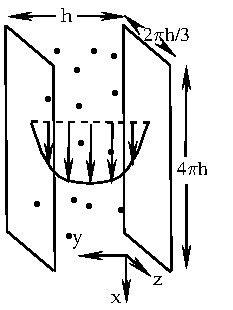(493d) Turbulence Collapse in a Dilute Particle-Gas Suspension
AIChE Annual Meeting
2022
2022 Annual Meeting
Engineering Sciences and Fundamentals
Nonlinear Flows and Combined Transport Processes
Wednesday, November 16, 2022 - 1:15pm to 1:30pm
The configuration consists of a pressure-driven turbulent channel flow bounded by two walls in the cross-stream direction, and periodic boundary conditions in the stream-wise and span-wise direction. Two different channel Reynolds numbers, 3500 and 5600 (friction Reynolds numbers 115 and 180) are used, and Direct Numerical Simulations (DNS) is used for computing the fluid turbulence. Discrete spherical particles are simulated explicitly, with particle Reynolds number (ratio of fluid inertia and fluid viscosity at the particle scale) in the range 60-104, and Stokes number (ratio of particle inertia and particle viscosity) up to 420. The particle volume fraction is very low, in the range 10-3 - 5 X 10-3, but the particle mass fraction is in the range 0.2-20, because the ratio of particle and gas densities is large. There is two-way coupling, that is, the fluid exerts drag and lift forces on the particles, and the particles exert a reverse force on the fluid which modifies the fluid turbulence. A linear drag law with inertia correction (called the Schiller-Naumann correlation) is used for the drag force, and the Saffman lift force is also included, and inter-particle collisions are also included.
The simulation results show that there is a discontinuous decrease in the turbulence intensity due to the particle force at a critical volume fraction of the order of 10-3. At this critical volume fraction, when the volume fraction is increased by a small increment of 0.5 X 10-4, the fluid turbulence intensities decrease by 1-2 orders of magnitude. The dependence of the critical volume fraction on the particle Reynolds and Stokes numbers has been determined. The transition is found to be robust and repeatable; simulations performed with different initial conditions and initial disturbance amplitudes result in the same turbulence collapse phenomenon. When the particles are removed from a turbulent suspension below the critical volume fraction, the flow reverts to an unladen turbulent flow. If the same test is carried out above the critical volume fraction, the flow reverts to a laminar flow. This suggests that below the critical volume fraction, the particle fluctuations are driven by the fluid turbulence; in contrast, above the critical volume fraction, the fluid velocity fluctuations are driven by the particle drag force.
An energy balance analysis is carried out to examine the mechanism of turbulence collapse. At transition, it is observed that there is a discontinuous decrease in the turbulent production of energy, and no comparable increase in the dissipation due to drag. This is contrary to the conventional wisdom that the turbulence attenuation is due to the drag force on the particles, and suggests an alternate explanation that it is the turbulent production of energy that is disrupted due to the particles. The effect on the fluid turbulence was further examined by preferentially modulating particle motion across turbulent structures of different sizes in the flow. It is observed that there is turbulence collapse only when the particles travel across the largest turbulent structures in the flow, and the time scale for particle motion is comparable to the largest eddy turnover time. Turbulence collapse is not observed when particle motion is restricted to the region of maximum turbulent production close to the wall. This suggests that particle interaction with the large scale turbulent structures results in a disruption of the turbulent production mechanism leading to turbulence collapse.
